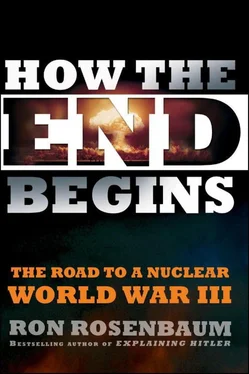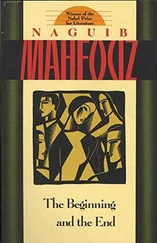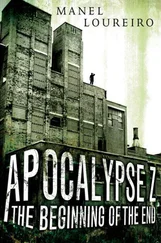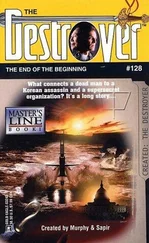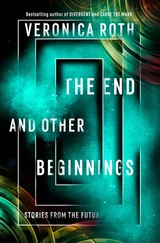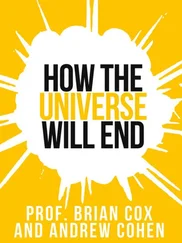There were those who pointed out that in terms of sheer numbers the new treaty could prove to be a step backward. While the treaty officially reduced the maximum number of warheads from 2,200 on each side to 1,500, “Because of quirks in counting warheads aboard heavy bombers” Jonathan Weisman and Peter Spiegel wrote in the April 9 Wall Street Journal, “the actual number of nuclear weapons could be considerably higher in seven years.” [285]Each “heavy” nuclear bomber—“heavy” as defined by capacity—was counted as a single weapon, just as if it were the single warhead of a missile, despite the fact that each bomber could be loaded up with a dozen or more warheads and bombs, and up to seven hundred of them were permitted.
Even more demoralizing, nothing at all was done to change the alert status of missiles on either side of the standoff. Anyone who spent more than ten minutes studying the document would discover the alert problem was addressed in a highly disingenuous way. [286]In the Introduction to the NPR there is on page x, a section with the astonishingly misleading title “Maximizing Presidential Decision Time.” [287]But does the new NPR actually do anything to maximize presidential decision time? No. It flatly declares that nothing will change. “The NPR concluded that the current alert posture of U.S. Strategic Forces—with… nearly all ICBMs on alert and a significant number of SSBN’s on alert at sea at any given time— should be maintained for the present [italics mine],” the executive summary heading of the report says. [288]
In other words despite titling the section as if it were actually doing something to maximize presidential warning time, like getting those ICBMs off hair-trigger alert, it committed us to the current destabilizing situation more deeply and defiantly.
The only way the authors of the NPR justify that title is by weakly suggesting “efforts should continue to further diminish the possibility of nuclear launches resulting from accidents, unauthorized actions or misperceptions and to maximize the time available to the president to consider whether to authorize the use of nuclear weapons.” [289]But in its effect the NPR has made it acceptable for those efforts to be disregarded.
General Kevin Chilton, head of STRATCOM, had told me months earlier in Omaha that he lost sleep over the morality of retaliation, but in fact it seemed more like the wily warrior worked sleeplessly to mobilize the Pentagon and Defense Secretary Gates against incorporating Obama’s campaign pledge to take missiles off hair-trigger alert into the NPR. In the end, he won the fight he had picked with his commander-in-chief.
The Obama defenders have argued the administration didn’t want to go too far with changes in the Nuclear Posture Review because they didn’t want to jeopardize chances of ratification of the new START treaty, which depends on a two-thirds majority in the Senate, sixty-seven votes. [290]
And there were those who said that whatever one thought of the treaty agreement specifics, just the act of having come to some agreement with the Russians established a framework for further rational reductions that could eventually lead us significantly closer to Zero. [291]On the other hand there were those who said new START was really an end because any further treaty would have to consider Russian demands to limit ballistic missile defense, an issue upon which the two sides seemed unalterably divided. [292]
Meanwhile, while all this U.S. and Russia nuclear peacemaking was making headlines, Iran was boasting of a new generation of nuclear fuel enrichment centrifuges whirling somewhere beneath the ancient hills of Persia. [293]Israel announced a stepped-up program of building underground shelters under public buildings such as theaters and sports arenas throughout the land, and its Dolphin-class submarines cruised somewhere in the Persian Gulf carrying what the world supposed were nuclear missiles. [294]
And then there was the dog that didn’t bark. No throngs of people in the streets of the cities of the world joyously celebrating the Prague treaty the way throngs had filled the cities to support a nuclear freeze in the 1980s when there had been a nuclear peace movement. That movement didn’t stop the deployment of Pershing II intermediate-range missiles, but may have led ultimately to the intermediate-range ballistic missile treaty, which eventually removed them as well as their close-range Soviet counterparts. Thirty years later, the little left of that movement was just a bunch of extremely thoughtful and articulate arms control and Zero advocates located in several think tank buildings off DuPont Circle in Washington, D.C. Meanwhile General Chilton has the Pentagon, and the missile crewmen on hair-trigger alert still have the keys.
Are the nuclear abolitionists cultists or visionaries?
It has been nearly three decades since the no-nukes and nuclear freeze movements reached its high-water mark at the height of the Cold War with the international marches and 1979’s celebrity-saturated nuclear Woodstock of the Jackson Browne–led No Nukes concert in Madison Square Garden. And an undergrad at Columbia, Barack Obama, wrote an essay for the school paper supporting the nuclear freeze. [295]
Since the freeze fizzled and the Cold War did too, nuclear abolition had become at best a low-priority impossible dream concern for the left, at worst little more than a nostalgic memory associated with tie-dyed T-shirts and hippie communes. But a quarter-century after the No Nukes concert, in January 2007, two years before President Barack Obama declared “a world without nuclear weapons” a national goal, who should come riding to the rescue of the no nukes movement but that ol’ peacenik Henry Kissinger in that tie-dyed hippie venue, the op-ed page of the Wall Street Journal . [296]
It could be said that the history of the nuclear abolition movement in the second nuclear age began with a kind of bolt from the blue: a manifesto entitled “A World Free of Nuclear Weapons” signed by Kissinger, the legendary master of Machiavellian realpolitik, along with Reagan-era Secretary of State George Shultz and two former Democratic Party nuclear policy luminaries, Clinton-era Secretary of Defense William Perry and Senator Sam Nunn. Jointly these four defense-credentialed realists called not just for nuclear “freeze,” not just for nuclear reductions, but for nuclear abolition, for specific steps to be taken to eliminate all nuclear weapons from the world’s arsenals. To many it was shocking, even mystifying.
Kissinger, after all, came to prominence as the author of one of the texts that shaped our accumulation and maintenance of a vast nuclear arsenal, his 1957 book Nuclear Weapons and Foreign Policy. And as secretary of state, he and Shultz had presided over the seemingly endless SALT talks that for two decades had both stabilized and entrenched the nuclear balance of terror. But there was no mistaking the seriousness of their unexpected plea for nuclear abolition.
In the manifesto they go beyond strategic and tactical considerations to argue that the continuing possession of nuclear weapons is a profound threat to the psyche and soul of civilized society:
Unless urgent new actions are taken, the US soon will be compelled to enter a new nuclear era that will be more precarious, psychologically disorienting, and economically even more costly than was Cold War deterrence. It is far from certain that we can successfully replicate the old Soviet-American ‘mutually assured destruction’ with an increasing number of potential nuclear enemies world-wide without dramatically increasing the risk that nuclear weapons will be used. New nuclear states do not have the benefit of years of step-by-step safeguards put in effect during the Cold War to prevent nuclear accidents, misjudgments or unauthorized launches. The United States and the Soviet Union learned from mistakes that were less than fatal. Both countries were diligent to ensure that no nuclear weapon was used during the Cold War by design or by accident. Will new nuclear nations and the world be as fortunate in the next 50 years as we were during the Cold War?
Читать дальше
